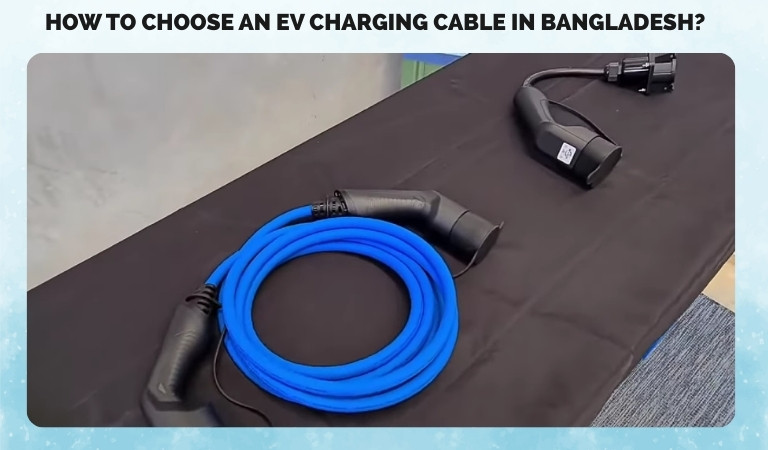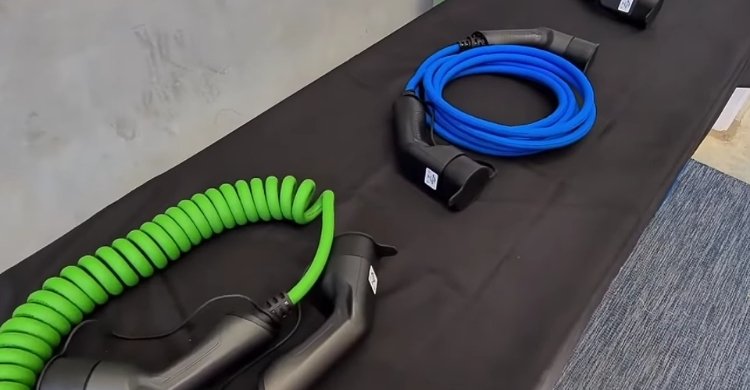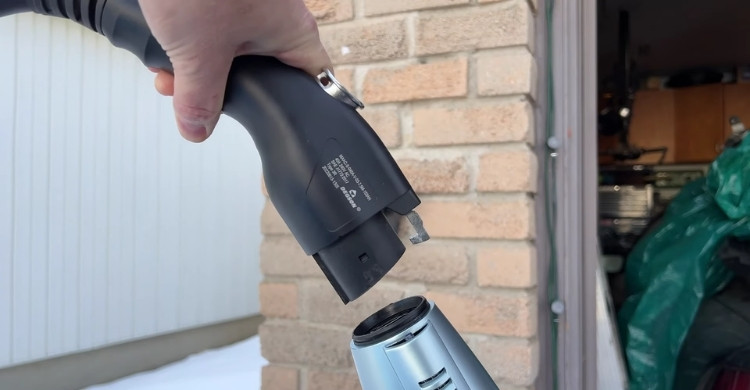When you get an electric vehicle (EV), picking the right charging cable is crucial. In Bangladesh, where more people are starting to use EVs, it’s important to know how to make the best choice. There are different types of cables and features to consider, and it can seem a bit confusing at first. But it’s actually quite straightforward once you know what to look for.
So, how to choose an EV charging cable in Bangladesh?
First, check if the cable fits your car’s plug type — either Type 1 or Type 2. Make sure the cable is long enough to charge your car where you plan to do so, and that it is compatible with our local electric system. If you’ll charge your car outside, look for a cable that can handle the weather. Always buy from reliable sellers and check that the cable meets safety standards.
Read on to learn more about picking the right EV charging cable for your needs!
How to Choose an EV Charging Cable in Bangladesh: Step By Step
Electric vehicles (EVs) are becoming more popular in Bangladesh. To charge your EV safely and quickly, you need the right charging cable. This guide will help you pick the best cable for your car in seven easy steps.

Step 1: Check Your EV’s Connector Type
Before anything else, find out which connector your EV uses. Some cars use CCS for fast charging, while others, especially Japanese models, use CHAdeMO. If you’re charging at home, your car might use an AC Type-2 connector. Matching your cable to the right port is the first step to safe charging.
Step 2: Match the Voltage and Current
EVs can charge at different voltage levels, so your cable must support the right one. Level 1 charging needs cables that work with 120V, while Level 2 needs 240V support. Fast DC charging cables are designed for high-voltage use. Always check both your car’s needs and the station’s output.
Step 3: Choose the Right Cable Length
Cable length is important when charging your EV at home or outside. A short cable may not reach your car easily, while an extra-long one can waste power. Measure your parking space and buy the cable that fits best. Avoid overly long cables to reduce energy loss during charging.
Step 4: Pick a Durable and Well-Insulated Cable
Weather and wear can damage weak cables. Choose one with strong insulation like PVC or XLPE that resists heat, moisture, and cuts. If you charge outdoors or in rough areas, go for armored or flexible cables. This keeps your charging setup safe for longer use.
Step 5: Look for Certified Safety Standards
A safe charging cable will always meet local and global safety rules. Make sure the cable is approved by groups like BSTI or IEEE. These cables are tested to avoid issues like overheating or short circuits. Buying certified cables gives peace of mind and better safety.
Step 6: Think About the Price and Quality
All cables do not cost the same, and price often depends on quality. While cheaper cables may save money now, they often don’t last as long. Investing in a good cable means fewer problems later. For example, the Crack Platoon EV charger offers strong performance with solid safety features.
Step 7: Explore Extra Features for Better Use
Some charging cables come with helpful features like smart charging or built-in adapters. These can adjust power levels or connect with more than one port type. Features like these add convenience and flexibility. If you want a smooth charging experience, it’s worth looking into them.
Types of EV Charging Cable Available in Bangladesh
Electric vehicles are becoming more common on the roads these days, and charging them the right way really matters. If you have an EV or are planning to get one, you’ll need to know about the charging cables. There are a few different types available, and each one works in its own way. Learning about these cables can help you pick the best one for your EV.

AC Charging Cables
These cables are mostly used at home or in places where charging takes longer. They usually connect to a regular power outlet and work at a lower speed. AC charging is good for people who charge their car overnight or for a long time. It’s safe and easy to use for daily charging. Many EV owners start with this kind of cable.
DC Fast Charging Cables
DC fast chargers are used when you want to charge your EV quickly. These cables send power directly to the car’s battery at a much faster rate. They’re often found at public charging stations or along highways. If you’re in a hurry or going on a long trip, this is the type to look for. However, not all EVs support DC charging, so it’s good to check first.
Type 1 Cables
Type 1 cables are mainly used for older models of cars that are made in Japan or the USA. They work with single-phase power and are good for slower AC charging. This type of cable has a five-pin plug and is not very common in newer vehicles. If your car supports Type 1, make sure you find the matching cable. It’s simple and does the job for everyday use.
Type 2 Cables
Type 2 cables are more popular in Bangladesh and used in most new EV models. These cables support faster AC charging and work well with public charging stations. The plug has seven pins and is safer and more advanced than Type 1. It also supports both single-phase and three-phase power. This makes it a better choice for people who want quicker home or public charging.
CHAdeMO Cables
These cables are mostly found with Japanese EV brands like Nissan. CHAdeMO is used for fast DC charging and has a unique plug shape. It lets you charge your car quickly, which is great when you’re short on time. The cable is thick and strong, but it’s not used as much in newer cars. Make sure your EV supports CHAdeMO before buying one.
CCS Cables
CCS stands for Combined Charging System, and it’s becoming very popular. It supports both AC and fast DC charging, which makes it super flexible. Many European and newer EV models use this cable. The plug combines a regular AC port with two extra pins for DC charging. If your car supports CCS, it’s one of the best options to go for.
Are All EV Charging Cables Compatible with Every Car?
No, not all EV charging cables work with every electric vehicle. Different EVs use different connector types and charging systems. If you pick the wrong cable, your car might not charge properly or may not connect at all. That’s why it’s really important to check your car’s plug type before buying any cable.
Some EVs use Type 1, others use Type 2, and some support fast charging like CCS or CHAdeMO. Always match the cable with your EV’s charging port and power needs to avoid charging problems. For example, if you want to install an EV charger in an apartment in Bangladesh, you must pick a cable that fits both your EV and your local power system. A correct match helps your EV charge faster, safer, and without any trouble.
Why Do You Need to Choose the Right EV Charging Cable?
Electric cars are becoming more common, and charging them the right way is super important for every owner. If you choose the wrong cable, you might face problems that waste time or even damage your vehicle. Understanding which cable fits best helps avoid those issues easily. So, let’s see why picking the right EV cable really matters.
Safe Charging
Using the right cable keeps your EV safe while charging. A wrong or poor-quality cable can overheat and cause harm. The right cable is made to match your car’s power needs. It also protects you from electric shocks and short circuits. Safety should always come first when using electric devices.
Proper Fit
Not all EVs have the same type of plug, so your cable needs to match perfectly. Some cars use Type 1, others need Type 2, and some support fast charging. If the plug doesn’t match, your car simply won’t charge. A correct fit makes charging smooth and easy every time.
Faster Charging
Right cables help your EV charge faster without any delay. If you use a cable with the wrong power rating, charging can take much longer. A proper cable works well with both the car and the charger. This means you can spend less time charging and more time driving. It also saves electricity by charging more efficiently.
No Power Loss
Long or low-quality cables can cause power drops during charging. That means your car may not get the full amount of electricity needed. A good cable will keep the power flow steady and strong. This makes sure the battery charges properly every time. Avoiding power loss is better for your EV’s health.
Works with Chargers
The cable also needs to match the charging station you’re using. Some public chargers support only certain plug types or power levels. If your cable doesn’t match, it may not connect at all. The right cable connects easily with both home and public chargers. This gives you more options when you need to charge.
Lasts Longer
Strong cables with proper insulation last longer and handle heat, rain, or even rough use better. A poor cable may get damaged quickly, leading to extra costs. If you choose a durable one, you don’t need to replace it often. It also keeps your charging experience stress-free. That’s why it’s worth getting a good one from the start.
Saves Money
When you use the correct cable, your EV works better and doesn’t waste power. It also keeps the battery healthy, which can save money on repairs. A wrong cable might seem cheap but can cause bigger problems later. Spending a bit more on a good cable can help avoid future costs. So it’s smarter to choose wisely now.
Tips for Safely Using and Maintaining Your Charging Cable
Charging your electric vehicle should always be safe, simple, and smooth every time you plug it in. Many people forget that taking care of the charging cable is just as important as the charger itself. A few smart habits can help your cable last longer and work better. Here are some easy tips to keep everything running smoothly.

Check for Damage
Always look at your cable before you use it, even if you’re in a rush. If you see any cracks, cuts, or burns, stop using it right away. Damaged cables can lead to shocks or even short circuits. Fix or replace any faulty parts as soon as possible. A small issue can turn into a big one if ignored.
Keep It Dry
Water and electricity never mix well, so always keep your cable away from puddles or rain. If the cable gets wet, dry it completely before plugging it in. Even the best cables can fail if used in wet conditions. Try charging in covered areas whenever possible. This helps prevent accidents and keeps your cable safe.
Store It Properly
When you’re not using your cable, don’t leave it on the ground or in messy places. Roll it up gently and keep it in a clean, dry spot. Avoid folding it too tightly or hanging it by the plug. Good storage habits help the cable keep its shape and avoid damage. This also makes it easier to use next time.
Use the Right Charger
Make sure the cable you’re using matches the charger and your car’s requirements. If you’re wondering about the difference between smart and regular EV charger, it’s also good to know which one your cable works best with. Using the wrong combination can lead to overheating or poor charging. Always check the instructions before plugging anything in. A correct match gives safe and faster charging.
Avoid Overheating
If your cable or plug feels hot while charging, stop and check everything. Overheating can happen when the cable is too thin or the connection is loose. Let the cable cool down and then plug it back in if everything looks fine. If it still gets hot, use a better cable or talk to an expert. It’s better to be safe than sorry.
Clean It Regularly
Dust and dirt can collect on your cable and inside the plug ends. Use a soft, dry cloth to wipe it down once in a while. Don’t use water or any cleaning sprays. Keeping the cable clean helps it work better and last longer. A clean cable is also safer and easier to handle.
Frequently Asked Questions about EV Charging Cable in Bangladesh
Picking the right EV charging cable may seem confusing, especially with all the options available. But with a little help, you can easily understand what to look for. Here are some common questions to guide you better.
Can I Use the Same Cable for Home and Public Charging?
Not always. Some public chargers need specific connectors or support fast charging, which home setups might not. It’s best to check both charger types and ensure your cable fits both if you plan to use them regularly.
What If My EV Has a Built-In Charging Cable?
Even if your EV has a built-in cable, it’s still smart to have a separate one. External cables are helpful when the built-in one can’t reach or isn’t suitable for certain stations, especially for outdoor or long-distance charging.
Is a Longer Cable Always Better?
Not really. A longer cable might seem useful, but it can lead to power drops or get in the way. Choose a cable just long enough for your parking space to avoid energy waste and tangles.
How Do I Know If a Cable Is Weatherproof?
Check the product label or ask the seller if the cable is weather-resistant. Look for materials like PVC or rubber with IP ratings. These cables work well in rain or sun, making them perfect for outdoor charging setups.
Should I Worry About the Cable’s Brand?
Yes, brand matters. Well-known or certified brands usually follow safety rules and use strong materials. Cheap or unknown brands might fail quickly or be unsafe, so buying from a trusted supplier is always the smarter option.
What Happens If I Use The Wrong Cable?
Using the wrong cable can stop your car from charging or even damage the charger port. It may also overheat or fail to deliver proper power. Always match the cable with your EV and charging station to stay safe.
Can One Cable Be Used for Multiple EVs?
Only if those EVs have the same plug type and voltage needs. Using one cable for different EVs can be risky without checking compatibility. If you plan to share, confirm that the cable matches both cars’ connector types first.
Do I Need Special Cables for Fast Charging?
Yes, fast charging needs cables designed for higher voltage and current. Normal cables can’t handle the power safely and may overheat. Always check if your EV supports fast charging and then get a cable that matches those requirements.
Last Words
Picking the right EV charging cable is not as hard as it may seem. You just need to know a few simple things like the plug type, cable length, and if it’s safe to use. Learning how to choose an EV charging cable in Bangladesh helps you charge your car faster and in a safer way.
The right cable also keeps your car’s battery healthy for a longer time. Make sure the cable works well with your car and the charger you use. Also, look for one that’s strong and doesn’t get damaged easily. If you follow these easy tips, charging your EV will always be safe and simple.
